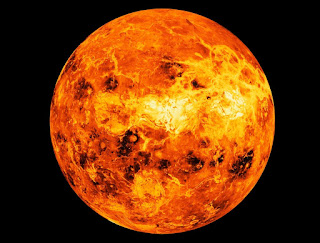Venus
Venus spins on its axis clockwise, making it the only planet in the Solar System that spins in retrograde, or opposite spin of Earth and all the other planets. There are more volcanoes on Venus than any other planet. Astronomers have discovered over 1,600 volcanoes on Venus so far. Scientists think that most of these volcanoes are dormant.
A
day on Venus lasts 343 Earth days, while a year on Venus is shorter, at just
224.7 Earth days. Venus takes longer to
rotate about its axis than any other planet.
The days of Venus are longer than the years.
The
temperature on Venus can reach 870 degrees Fahrenheit due to an extreme
greenhouse effect and the atmosphere being made up of 96.5% carbon dioxide and
sulfuric acid. Venus has the hottest
surface of any planet, about 867 degrees Fahrenheit.
The air pressure on Venus is 90 times higher that the pressure at sea level on Earth, That’s equivalent to about half a mile under the ocean. Winds can reach 450 miles an hour on Venus. The Venusian winds are faster than the strongest tornadoes on Earth.
Venus
is the brightest natural object in Earth’s night sky after the Moon.
The highest point on Venus is Mt. Maxwell, over 7 miles high.
The
magnetic field of Venus is very weak compared to Earth,
In 1761, the atmosphere was discovered by Mikhail Lomonosov (1711-1765).
In December 1962, Mariner 2 flew by Venus. It was the first successful interplanetary mission, passing 21,644 miles above the surface of Venus. It discovered the rotation rate of Venus.
In 1966, the Soviet Venera 3 was the first human-made object to impact another planet’s surface when it crashed on Venus on March 1, 1966.
On
June 17, 1967, Mariner 5 was launched to Venus from Cape Canaveral.
On October 19, 1967, Mariner 5 flew by Venus at an altitude of 2,480 miles above its surface. Mariner 5 operations ended in November 1967.
In
October 1967, Venera 4 became the first spacecraft to measure the atmosphere of
another planet as it entered Venus’s atmosphere.
On December 15, 1970, Venera 7 was the first spacecraft to successfully land on the planet.
In 1974, Mariner 10 swung by Venus on its way to Mercury.
In 1975, Venera 9 and 10 landers transmitted the first images from the surface of Venus.
In May 1978, Pioneer Venus Orbiter (Pioneer 12) was launched from Cape Canaveral.
On December 4, 1978, Pioneer Venus Orbiter was inserted into orbit around Venus.
In
1982, Venera 13 and 14 landers took the first colored images of the surface of
Venus.
In
1983, Venera 15 and 16 were placed in orbit of Venus. They mapped 25% of Venus’s terrain.
On
May 4, 1989, the Magellan spacecraft was launched from the Space Shuttle
Atlantis. It was the first
interplanetary mission launched from the Space Shuttle. It flew 948 miles to get to Venus.
On
August 10, 1990, Magellan began orbiting Venus.
In 1991, the Magellan orbiter was the first to provide detailed images of the planet.
On October 1992, the last data from Pioneer Venus Orbiter was received and disintegrated upon entering Venus’s atmosphere.
On October 13, 1994, the spacecraft Magellan crashed into Venus after a five-year mapping mission that revealed large volcanoes, a river of lava 4,200 miles long, and crisp-edged craters on the surface. [source: The Index-Journal (Greenwood, SC), Oct 11, 1994, p. 6]
In
April 2006, the European Space Agency’s Venus Express entered orbit around
Venus. It took images of the atmosphere
from 124,000 miles, showing plae clouds turning around a dark vortex. [source: Ukiah
Daily Journal, Apr 12, 2006, p. 14]
In
2015, Japan’s Akatsuki spacecraft entered orbit around Venus.
About
20 probes have flown by or orbited or
landed on Venus.





Comments
Post a Comment